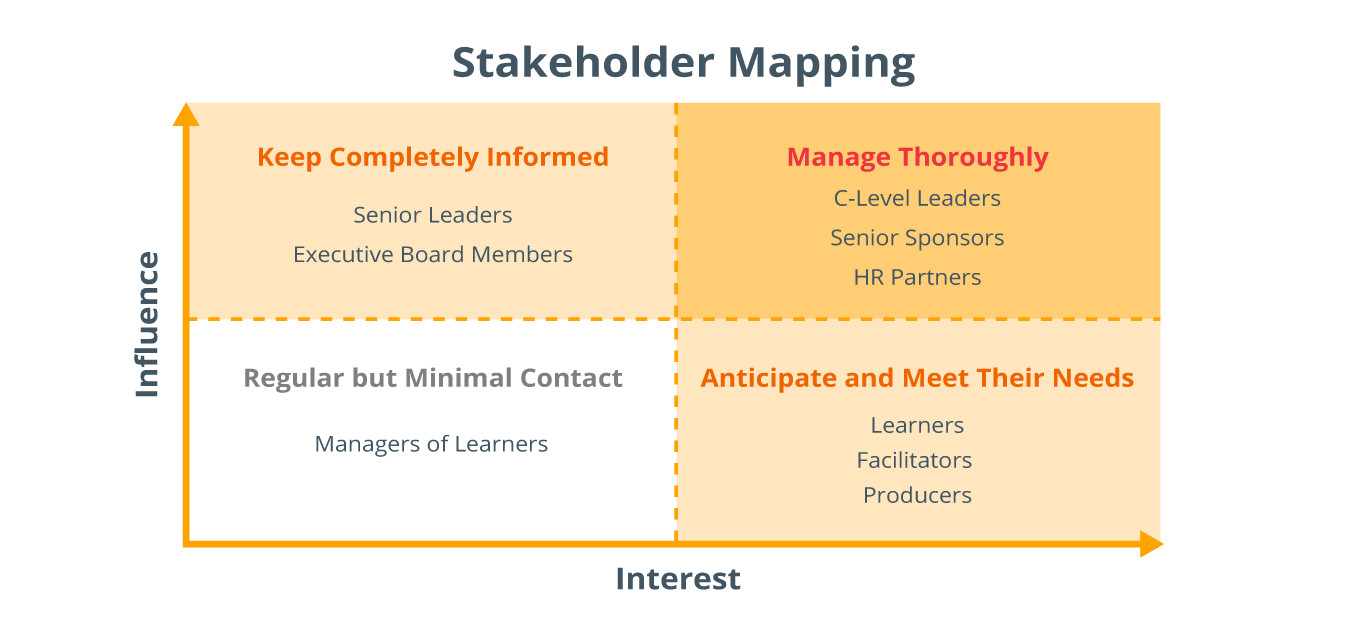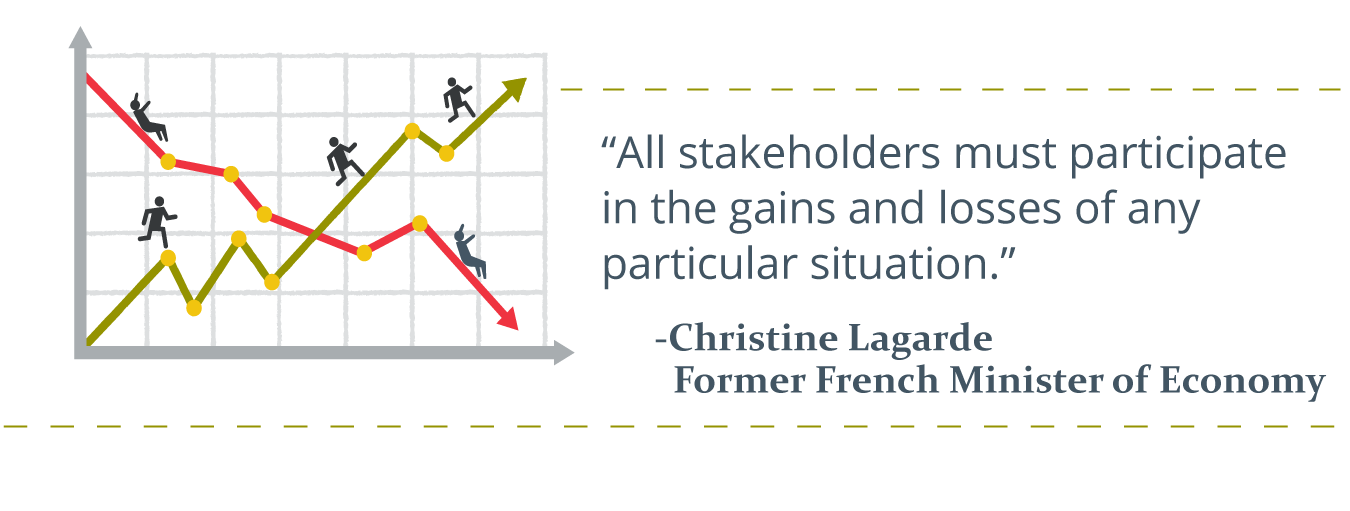Build Commitment with a Stakeholder Engagement Strategy
Your stakeholders can significantly accelerate—or slow down—your leadership development initiatives. Whether you’re early in the design phase or in the middle of a program, let’s explore why a stakeholder engagement strategy is important. You’ll also learn what you can do to build internal champions and get the support you need.
What Is Stakeholder Engagement?
Stakeholder engagement is a planful approach to identify, understand, and implement specific actions designed to influence, build confidence, or foster buy-in among key individuals or groups. In the context of leadership development, stakeholder engagement is taking a proactive approach to involve and build commitment among those who will determine the success or failure of your program or initiative.
- Who do I need to engage and influence? The first step is to clearly identify your stakeholders, which we’ll explore further below.
- Why do I need their commitment? Perhaps you need their approval, time, or budget. Or maybe the person’s point of view is important to someone whose commitment is essential to moving ahead.
- What level of commitment do I need from this person? You will need some key people to be champions for your program. But every single person doesn’t have to be a raving fan. Even if some stakeholders aren’t making the rounds to promote the program, you may still need their commitment to support and follow through on the program.
- How will I gain their commitment to take action? Considering what is unique about each individual will help you choose the best strategies to engage, influence, and gain commitment.
Why Is Stakeholder Engagement Important for Leadership Development?
You’re not looking for a quick one-and-done deal. Leadership development has the potential to transform your organization’s culture and success, but only if everyone involved is aligned and committed towards the same vision, goals, and expectations. With strategic alignment among your key stakeholders, you have an extended team to share the load of supporting the initiative and driving toward success.

Who Are the Stakeholders That Matter?
The first step is to identify your stakeholders. Here are some key questions to ask:
- Who is the key stakeholder or executive sponsor?
- Who is involved and who will benefit from your leadership development initiative?
- Who are your key sponsors and allies in various business units and locations?
- Who are all the other stakeholders that have a vested interest in this initiative?
From our experience working with clients, here’s a list of typical stakeholders for leadership development initiatives:
- Executive sponsor
- Learners or participants
- Managers of participants
- Learning and development team
- HR business partners or broader HR/talent community
- Business or functional group leaders—i.e., IT
- Direct reports of participants
Next, conduct a stakeholder analysis to help you visualize and understand the relationships, hierarchies, and interactions between all of the people who have an interest (or stake) in your initiative. Be intentional about identifying your stakeholders as you create a plan to engage and involve them. Here are some questions that can help:
- What do they want as a result of leadership development?
- What do I need from them to ensure success of this initiative?
- How do I keep them informed?
- Are there any challenges or potential barriers I need to consider that they may either create or help remove?
How Can My Stakeholders Get Involved?
Clients often ask us which stakeholders are most important for leadership development initiatives. These are our top three, along with ways you can engage them:
- Executive sponsor: You need a C-level or senior executive for top-down support and visibility across the organization. Your executive sponsor can also advocate for ongoing budget and resources. Whether it’s your CEO or CHRO, ask for their help as a key spokesperson for the program. They can be featured in welcome videos, deliver a kickoff message, or take part in a capstone event. Above all, keep your executive sponsor involved and the ROV (Return on Visibility) will pay off.
- Learners or participants: Your leadership development initiative is designed for them—and their meaningful engagement and participation is obviously crucial to its success. Too often all of the learner’s energy is focused on the launch with little left for the ongoing “care and feeding” required to sustain engagement and ensure results. So it may help to think of learners as your internal customers. You can keep them engaged by highlighting the benefits of the program for their career and providing on-demand tools and more opportunities for development. Plus, recognition and ongoing support from L&D teams and their managers show that their journey as a leader is important for the organization.
- Managers of participants: You’ve probably heard your learners ask, “Is my boss going through this, too?” What they are really asking is, “What kind of support can I expect from my boss?” Managers need to understand their role and what’s expected of them to support leadership development—not as a one-time event, but on an ongoing basis. Research has shown time and again that manager support is crucial for learners to apply new skills back on the job. Check out the section on Manager Support in this Guide.

But Not All Stakeholders Are Equal, Right?
It’s nice to make everybody happy. But obviously, not every stakeholder can be involved in the details of your program.
After you’ve documented stakeholder roles, needs, and expectations, you can cluster them by level of influence in the organization and their interest in leadership development. Taking time to map your stakeholders against a simple quadrant can help you differentiate your next steps.
Stakeholder mapping gives you an opportunity to zoom out and take a big-picture look. Each quadrant enables you to plan out your communication strategy with each group of stakeholders. Here’s an example of what that could look like:

Stakeholder Mapping: The Quadrants Explained
- Manage Thoroughly. Stakeholders with high influence and high interest, such as your Chief People Officer or CHRO, executive sponsors, and key HR partners, need to be fully engaged. These stakeholders need to champion your leadership development program as you will likely tap them to build excitement across the organization. It’s also likely that you’ll want them to be key partners in your implementation plan. Expect to communicate frequently and share information and details with this group through regular check-ins and 1:1 meetings.
- Keep Completely Informed. This group of high-influence stakeholders may not be interested in the day-to-day details of your leadership development program. For example, outside of your executive sponsors, it’s great to have the support of senior leaders like your Executive Board. But it would be sufficient to give them an overview of your program and its goals without getting into the tactics of your rollout plan.
- Regular but Minimal Contact. You may not need to involve stakeholders with a lower level of influence in the organization as actively or frequently. They likely have lower interest in the details of your program, so only share information when it is most relevant for them. You may reach out or connect with them through a virtual group session or a newsletter. For example, managers of learners may not be as visible and influential in the organization as your executive sponsor, but they are definitely influential in the success of your leadership development program! You will want them to be invested without getting bogged down with unnecessary details.
- Anticipate and Meet Their Needs. Last but not least is your high-interest group of stakeholders who do not have as much influence in the organization. This group includes the learners or participants themselves as well as facilitators or virtual classroom producers. Each has a variety of needs and expectations, and you can plan for many opportunities to engage with this group.

So What’s at Stake? Success!
We call them “stakeholders” because there’s something at stake for them! Each has a vested interest in the outcomes of your leadership development initiative. And your goal? To get your stakeholders on board to drive towards developing better leaders. The sooner you can engage your relevant stakeholders, the sooner you will benefit from their support and commitment.
